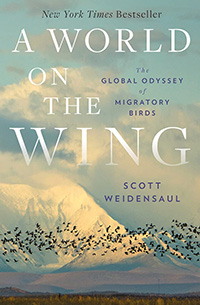 Scott Weidensaul, A World on the Wing; The Global Odyssey of Migratory Birds (New York: W.W. Norton, 2021), 385pp.
Scott Weidensaul, A World on the Wing; The Global Odyssey of Migratory Birds (New York: W.W. Norton, 2021), 385pp.
About 200 years ago John Audubon tied a silver wire to the legs of Eastern Phoebes on his estate in Pennsylvania. He wanted to know if those same birds returned to his property the next year to nest. And so began the fascinating study of bird migrations.
One main takeaway from Scott Weidensaul's remarkable book is how modern technologies have revolutionized migration research in the last twenty years. Today scientists attach nano tag transmitters to birds, some of which weigh a mere two-tenths of a gram. These geolocators provide a "stupefying" amount of Big Data and incredibly precise details, often in near-real time, about bird migrations. There are still many "profound mysteries" about bird migration, and the field is inherently complex and difficult, but much of the guess work has been eliminated.
Weidensaul documents dozens of examples of the nearly incomprehensible feats of birds. We know that Arctic terns migrate 50,000 miles a year. Albatrosses with an eleven-foot wing span "between biennial breeding attempts fly 74,000 miles, circumnavigating Antarctica two or three times without ever seeing land." One common swift that was banded lived an unusually long life of 18 years, which meant that over the course of its life it flew some four million miles, most of that without ever landing. Bar-headed geese and ruddy shelducks fly over the Himalayas at an altitude of 4.5 miles, where the temperatures are frigid and the oxygen level is a half to a third that of sea level. Two birds that were tracked together in their 8,000-mile migration landed within twenty miles of each other.
There are few aspects of bird migration that Weidensaul does not explore. His book is equal parts personal memoir, field notes, conservation efforts, scientific inquiry (eg, navigation by the earth's magnetic field), and travelogue. He reflects on his 50-years as "a serious bird geek" who developed a "curiosity bordering on mania" when he was a twelve-year old boy in rural Pennsylvania. Today he's a leading expert on the world's 10,300 bird species. He has written some thirty books; his volume Living on the Wind: Across the Hemisphere with Migratory Birds (1999) was a finalist for the Pulitzer Prize.
Dan Clendenin: dan@journeywithjesus.net


